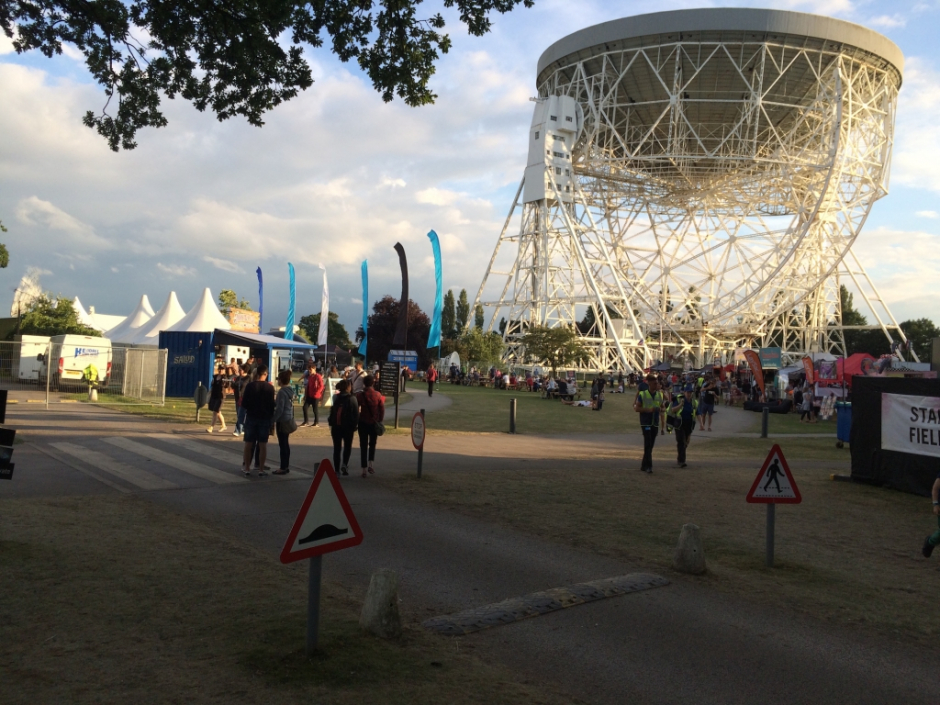Bluedot, Jodrell Bank Observatory, Orbit stage, July 7 2017.
Science, Storytelling, Magic and the Universe. It’s been a starry three days at the 2017 Bluedot Festival. I would have loved to cover it all, unfortunately the TARDIS was in for repairs and so I had to make do with my, limited, human resources and the experience of time remained stubbornly linear. So, amongst all the fabulous performances, here’s a brief summary of some choice picks:
Friday began with, well, a big bang. Tony Walsh led us through a brief history of the Universe with his ‘bitesized’ Zeros and Ones poem. We’re drawn into his starry vision of the cosmos, prompted by his ‘but listen to the tick, tick, boom’ of our creation. He lulls with his lyrical composition and the romance that comes with the promise of an ‘epic love poem.’ And then comes the turn, for Walsh has some big questions at the heart here: ‘what happens when all the world’s knowledge is the world’s knowledge’? Will our generation really leave ‘Generation Why The Hell Not?’ as the headline for our legacy? (I can’t help but feel that the tagline to that reads ‘meh’). It’s time surely, he urges, for us to consider just how will we ‘put the virtue in the virtual’, ‘the kind into kindly’, and ‘the her into history’. The questions expand like so many little thought bubbles into the air above us; it’s up to us to fill in the spaces for comment.
It’s a stirring performance and a beautiful opening to the festival.
From the emotional gravity of our collective responsibilities to the world we inhabit, to the laws of gravity we’re governed by. Our understanding of the cosmos has come a long way since Anaximander first created his mechanical model of the world and the image of earth floating in an infinite sky, (twenty-six centuries ago). On September 14th 2015 the Laser Interferometer Gravitational Observatory (LIGO) discovered a gravitational binary black hole signal in their data – one hundred years after Einstein proposed his spacetime ripples theory. It took LIGO another five months, approximately, to confirm this was evidence of a gravitational wave and not a blip in the system. This ground-breaking discovery of the existence of gravitational waves is the fascinating subject of Dr Marcus Chown’s talk: Gravity – The weakest and Strongest Force. Along the way, he covers, in brief: the big bang, primordial black holes, the existence of dark matter and dark energy. Dark energy, fascinatingly, is tension, a paradox: repulsion vs. desire, and then there’s string theory and its multiple dimensions.
Dr Chown speaks engagingly and eloquently on the history of revolutionary scientific discoveries, touching on Einstein’s beautiful theory of relativity to quantum theory and the nature of gravitational waves. So, what exactly is a gravitational wave? Well, imagine two binary black holes locked in a dark struggle, watch them kiss and coalesce. The force of their meeting, and the resulting implosion creates a new back hole that sets off ripples in timespace. It’s the implosion at the core of the stars that creates the first explosion and the black hole, Dr Chown stresses. No, we haven’t moved into the realms of science-fiction and Dr Chown hasn’t slipped into describing the latest Dr Who episode. This is an actual event, observed and recorded. The ripples emitting from the black hole are gravitational waves LIGO detected.
Space time, we learn, is a thing, it can be stretched and vibrated. Gravitational waves are the voice of space. That’s right, we can hear the universe. We’re helped along in our understanding with accompanying illustrations: think valleys in space, spinning carousels, planets like Russian roulette balls falling at the same rate as they are spinning around the sun creating gravitational waves travelling outwards.
Put simply, planets circle around the sun and things fall because space curves (this is aptly demonstrated with marbles and balls in a bouncy trampoline-like contraption set up in Star Field’s science marketplace, one of the many hands-on activities set up for festivalgoers).
We’re encouraged to create our own gravitational waves – how? Just put your hands in the air and wave them about, says Dr Chown. This is amazing, we’re all thinking, we’re literally stirring up the universe! And then he brings us back down to reality with his simple explanation on the relative strengths of our efforts and the amount of energy needed to make a gravitational wave strong enough to register with LIGO. Combined, we’re exerting less energy than that of an ant climbing a tree. Perhaps, though, sometime in the near future, say maybe 7th July 2021 or thereabouts, there’ll be a tiny little blip on a graph marking our attempt – or maybe not.
With each new scientific discovery in our expanding universe, the music of the spheres becomes that little bit clearer. Now if we can just figure out how to manipulate timespace, next stop: wormholes.
Intrigued? Then check out The Ascent of Gravity.
Dr Marcus Chown is an award-winning writer and broadcaster. He’s the consultant for New Scientist and the author of The Ascent of Gravity, What a Wonderful World, Quantum Theory Cannot Hurt You, Felicity Frobisher and the Three-Headed Aldebaran Dust Devil. His book We Need to Talk to Kelvin was short-listed for the 2010 Royal Society Book Prize, whilst App, ‘Solar System for iPad’ won The Bookseller Digital Innovation of the Year. Impressive. Even more impressive is the ease with which Dr Chown presents complex scientific theories for such a varied audience, keeping us rapt, despite having to compete with the booming bass of music from the surrounding stages.

